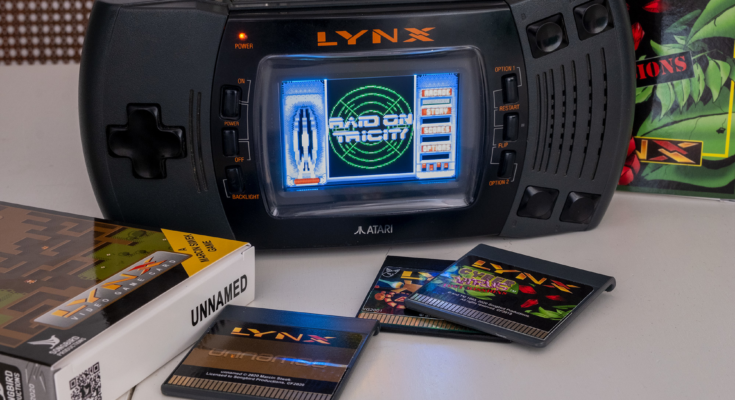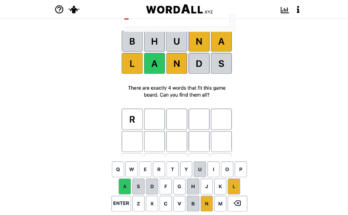If you’re a retro gamer, it’s hard not to ignore the Atari Lynx. The first color hand-held it might have been, but its small library of games (under 100 official titles) and general mishandling by Atari itself earned it little more than a walk-on role in gaming history for most people. As such, the homebrew and indie scene for the Lynx is pretty thin compared to its contemporaries (the Game Boy and the Game Gear).
The system still has its fans, though, (me included) and a few dedicated folks still hold a candle for the chonky handheld, with new titles now more common than they were a decade ago. But the real rarity is the full, physical release. Here are four new games you can play on original hardware, complete with cartridge and box, just as nature intended.
For Lynx diehards, there’s one destination to gather: AtariAge. And user Fadest (real name, Frédéric Descharmes) is one of the long-standing members of the handheld’s forum there. He’s perhaps best known for his Yastuna series of puzzle games. His two new releases keep the puzzle trend, but with a shoot-em-up/adventure twist.
Descharmes began programming for the Lynx as a way to channel his enthusiasm for retro gaming while he soothed his son to sleep late at night. He came to the Lynx specifically for its technological limitations (although it was advanced for its time). “I like the NES and Game Boy, and even code for them, but in my beginner situation, the Lynx was probably the best choice when I started in 2004,” he told Engadget.
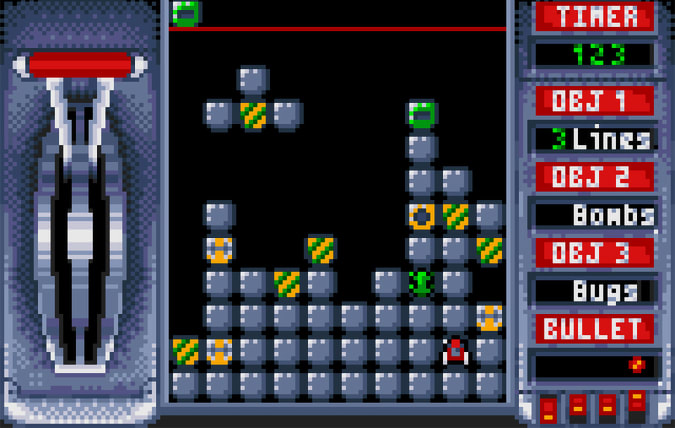
Fadest
Raid on TriCity takes the classic Tetris format and introduces a shoot-em-up component. As the blocks fall, you can’t move them or rotate them, but you can shoot them away brick by brick. You score, as normal, by completing lines (and not by shooting), and some of the Tetrominoes contain power-ups or enemies/ways to die.
Descharmes already released a pay-what-you-want ROM-only version of Raid on TriCity. “Second Wave” is essentially the same game as a physical release with some new in-game perks. The two most important ones would be the addition of an EEPROM for storing progress/high scores (no retail Lynx games ever had batteries or memory like some Game Boy titles did) and a new story mode which injects some life into an otherwise pick-up-and play time killer.
As simple as the game may sound, the hybrid dynamic picks the best elements of both genres and blends them to great effect. As you see blocks falling you have to make a quick decision about whether you want to go for a complete line, or whether a power-up might be more appealing or perhaps you have to sacrifice one to get rid of a baddie behind it. Sometimes this can be a bit of a gamble if a power-up you want has blocks above it that might bring you closer to the upper threshold and thus the end of the game.
Likewise, as lines complete and bring any power-ups above it one row down, a helpful bomb can become a death sentence (bombs trigger when a line is completed taking anything one square around it along with it — including your spaceship if you’re not careful).
The story mode isn’t exactly its own adventure, more it serves as a way to break up the game play with some narrative interludes and an element of interactivity in choosing your “path” through a network of levels. The levels themselves are really just more of the same shoot-a-block business, but it makes it feel more like making progress, and thus a game with an end to reach (rather than a high score to beat).
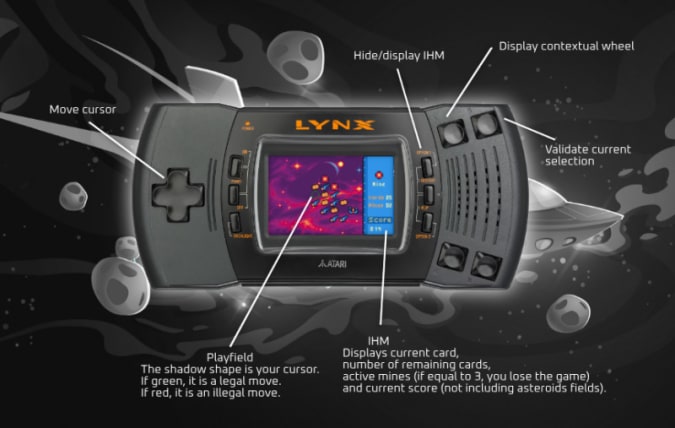
Fadest
Fadest’s second new title is another puzzler, but this time it’s more about strategy and fortune. I say fortune, but it’s usually mis-fortune to be fair. The game looks like it’s going to be a retro space shooter at first glance, but is more akin to a card game. Each turn you’ll be presented with an item/card and can only place it one square away in any direction from your last move. But each item/card will either be a scoring opportunity or a penalty of some kind.
This simple premise is deceptively addictive. There are four main “cards” to place: A probe, an asteroid (two types!) a mine or a pirate ship. Your job is to surround the asteroids with four probes to earn points (hence the game’s name). However, the pirates have other ideas and will disable any probes adjacent to them. This not only robs you of points, but can also be fatal: mines are diffused by surrounding them with probes, and you can only have three “live” ones on the map at any time. This means an ill-placed pirate, or just a string of bad luck with many mine cards can end your mission in a snap.
The goal is simple, reach the end of the “deck” while scoring as many points as you can along the way. At first, the game feels frustrating, as if you are merely at the whim of whatever cards are in the pile. And while this is true, you soon learn some strategies to increase your chances of getting to the end and racking up some points to boot.
For me, the fun of the game is built right into that frustrating nature. Many times I was killed early on, which only stoked my desire to beat the game and make it to the end. Once you do, you find yourself wanting to then beat your own high score. As with Raid on TriCity, Asteroid Chasers can remember your high scores giving the game longer term appeal. There are also many achievements to unlock (fortunately, also remembered) which will reward you with different music and other goodies giving this relatively simple game a lot more longevity than it first suggests.
Songbird Productions
If you’ve paid any attention to Atari’s handheld or the Jaguar indie scene in the last 20 years, you’ll be familiar with Songbird Productions. Not only is it a popular retailer of rare and homebrew games, its founder, Carl Forhan, is responsible for a number of Lynx titles being saved from obscurity by finding unfinished IP and seeing them through to completion, along with some original titles of his own.
One such title is CyberVirus, a first person space shooter. “In CyberVirus, I had to redo all the missions, redo the health and powerup system, and add new features to the game which were not in the original prototype.” Forhan told Engadget. I also enjoy the purity of these older, smaller machines where you have to fight for RAM and CPU cycles to do everything. It’s a fun challenge for my brain, I suppose.”
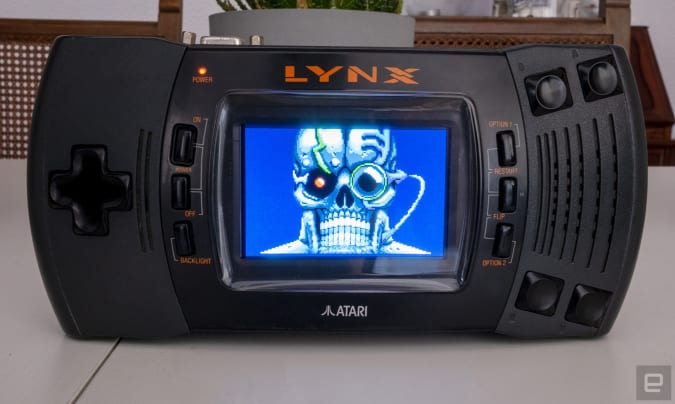
James Trew / Engadget
This new title, as the name suggests, is a follow-up to the original CyberVirus. The first version was released almost 20 years ago and is one of the “unfinished” games that Songbird rescued. It’s also a rare first-person/3D shooter on the Lynx. Lost Missions is a collection of levels that were also in the original, developed initially by Beyond Games, and presented to Atari as a demo back in 1993.
The nine new missions see you take on a familiar cast of robotic foes as you seek to achieve your objective. This could be as simple as destroying some communication towers, but the number of enemies soon ramps up making each mission exponentially harder. You have a selection of weapons at your disposal and a semi-open 3D world to explore, not bad for a console released in 1989.
CV-TLM will appeal to fans of early first person shooters like Doom, but instead of a complex map you must navigate open terrain. Thank’s to the game’s origins, the graphics and gameplay are much nearer to those found in official releases (given that this nearly was one) compared to even some of the more ambitious homebrew titles that have emerged since the Lynx’s commercial demise.
The result is a fun, frantic shooter that deserved to make it onto shelves back in the ’90s. Forhan’s given the game the next best thing in this release which comes with a slick, glossy box and a physical cartridge that’s indistinguishable from the originals (many homebrew releases, including the above are 3D printed).
The catalog of official releases for the Lynx tends to skew toward arcade titles, puzzlers and racing games. There’s a little bit of everything for sure, but adventure games and RPGs are generally lacking. Unnamed is a welcome salve, then, for fans of either of those genres. While the game is published by Songbird, it’s the work of Marcin Siwek who’s other Lynx title — Unseen — was a dark, choose your own adventure style game. Siwek’s second title is much more immersive with your onscreen character free to move around, find items and solve puzzles.
You awaken in a strange place with no memory of how you got there. Your task is to figure out why and how they find themselves in this strange world. Along your journey you find new rooms to explore and items to help you along the way. It’s a classic recipe, but one that lends itself particularly well to the handheld format.
Unnamed is refreshing, not just for its playstyle, but as a true indie game (rather than a rescued abandoned title) it has a surprising amount of depth and atmosphere. Within moments of playing, I knew that this is a game that I would truly want to “get into” and complete. As with Descharmes‘ titles, Unnamed features an EEPROM for saving progress meaning you can pick it up without having to start from scratch every time.
The graphics are a good blend of cute and sinister and the music strikes the perfect balance of ambiance without being a distraction. The challenges and puzzles to be solved are pitched just at the right level and there’s a genuine sense of wondering if you might have missed something — which might sound annoying, but I think is the hallmark of a good RPG.
All products recommended by Engadget are selected by our editorial team, independent of our parent company. Some of our stories include affiliate links. If you buy something through one of these links, we may earn an affiliate commission.
